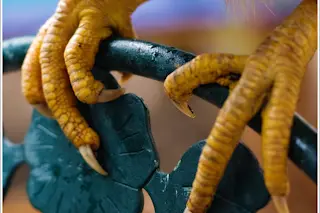(Credit: ap./Flickr) It may not be Jurassic Park, but it's certainly a step in that direction. Scientists from the University of Chile have successfully created chicken embryos with a unique feature: dinosaur legs. Don't imagine chickens stomping around with giant Brontosaur legs, though — the changes are all internal. The feature in question is the fibula, one of two bones inside the leg. In normal birds, the fibula stops about halfway down the leg, connected at the top but not the bottom, leaving it just hanging in space.
When chicken embryos form, they have a full fibula, but as they grow, the fibula stops growing along with them. Instead, it separates from the ankle where it was first attached and grows thinner and more spindle-like. Dinosaurs, like humans, had full fibulas to help support their massive weight. It seems that, at some point in their evolution, birds stopped needing the ...














